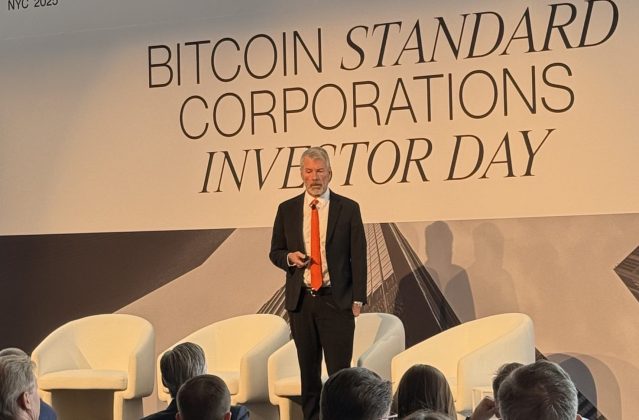Expert Blog is Cointelegraph’s new series of articles by crypto industry leaders. It covers everything from Blockchain technology and cryptocurrencies to ICO regulation and investment analysis. If you want to become our guest author and get published on Cointelegraph, please send us an email at [email protected].
Just a week ago, the Chicago Board of Exchange (CBOE) opened up its doors to trading Bitcoin Futures (XBT), and wrapped it up with a 17% gain on the January contract. Its larger, cross-town rival, the Chicago Mercantile Exchange (CME) just launched its own Bitcoin futures trading today. This has been fairly big news in the Bitcoin community, but many are still scratching their heads trying to make sense of it all. In this Expert Blog column, I attempt to explain what the implications are of these monumental events.
First, let’s take a step back and define what a futures contract is. A futures contract is simply a contract to buy or sell a financial instrument or other underlying asset at a predetermined price in the future. They can be settled by the physical delivery of the underlying goods, or in cash.
In other words, one party is speculating on the increase of the value of the underlying asset, and the other is hedging against the potential loss of value of it. The futures contract rewards the party that makes the most accurate prediction of the future value of the underlying asset.
Make sense?
So what does this mean for Bitcoin?
In the case of Bitcoin, a futures contract would allow two parties to speculate or hedge on the price of Bitcoin at some point in the future.
The important part of the above are the parties that would be speculating or hedging. Futures contracts are largely trade agreements for experienced traders and institutional investors. By allowing for these contracts to be traded in a regulated market, CBOE and CME have both opened up the doors for such traders to participate in the Bitcoin game and indirectly legitimize it as an asset class.
Keep in mind that because these contracts are settled in cash, the funds are not actually used to buy the underlying asset, only to speculate on its price movement. As such, introducing Bitcoin futures trading doesn’t necessarily directly improve the capital flow of Wall St. money into Bitcoin, but it can be expected to have tangential effects. For example, a hedge fund that previously abstained from going long Bitcoin, due to the lack of hedging tools, might now consider allocating Bitcoin it to its fund, using a series of futures contracts to protect against downside risk.
Also, Bitcoin futures contracts should, in effect, reduce the pricing volatility of Bitcoin, since the speculation allows the market to be more efficient, leading to better pricing discovery. With a reduction in the massive pricing swings, Bitcoin could become a more trusted medium of currency, as the durability of its short term pricing increases its utility value – in plain terms, allowing two parties to transact in Bitcoin without having to worry that it will be a vastly different price moments before or after the transaction.
Additionally, the public gains some additional insight into the combined market’s expectation of Bitcoin’s future performance. While futures markets are not necessarily always correct in their prediction, they do provide valuable data for traders and hodlers looking to gain some understanding of the current market sentiment. At the time of this article’s writing, it seems that the January contracts (XBT/F8) are putting a premium on the current price of Bitcoin, just one month out. In fact, just as the futures markets opened for the first time, the market price of Bitcoin on Coinbase jumped from $14,810 to $16,171 in a matter of minutes, demonstrating that, despite light volume, the futures prices may have some effect on its underlying asset.
Case for manipulation
Despite the potential for huge benefits to the Bitcoin ecosystem, there may be a few tradeoffs. The Bitcoin markets are still immature in comparison to a well-regulated, time-tested equities market like the NYSE-ARCA or NASDAQ. Despite what appears to be a healthy total circulation of coins, currently around $275 billion worth, the futures contracts are pegged off of a blended rate (CME calls this its Bitcoin Reference Rate or BRF), sourced from a handful of exchanges, or in the case of CBOE, just one exchange.
The issue with this is that these exchanges only trade a fraction of the total circulation. Gemini’s 24 hour Bitcoin volume represented just 1.6% of the global Bitcoin trade. With such small volumes and a thin order book, Bitcoin’s price could be subject to manipulation by a series of unscrupulous traders attempting to move the market in order to obtain favorable execution on highly leveraged futures contracts. Strategies that are illegal on a regulated exchange like NASDAQ are fair game in the cryptocurrency markets. Additionally, the Bitcoin market has proved to be sensitive to media coverage; even a single CEO of a globally recognized financial services firm has been proven to move the market using just a few words.
While it is the hope that futures trading helps to set the stage for a more regulated trading environment, we must not ignore the motivation by speculators to make large sums of money. As the saying goes, “where there is a will, there is a way” and it has happened on a number of occasions on well-regulated U.S. markets.
Final thoughts
While Bitcoin’s intent was to allow for parties to transact “without going through a financial institution,” the blessing by Wall St. and the U.S. government may be a necessary evil to allow for more widespread use, protection of the public, and eventually more confidence by a wider range of investors. Bitcoin futures represent an early case-study that if successful, may help to pave the way for approval of ETFs and other investment vehicles, further growing the ecosystem. If we’re lucky, this creates a virtuous, self-sustaining cycle of wealth creation, awareness and value.
Bio: Arthur Iinuma is Co-Founder and President of ISBX, a leading software consulting firm in Los Angeles. He was a former FINRA-licensed trader at Morgan Stanley and later VP at UBS. He is a cryptocurrency trader, and an accredited angel investor. Arthur is also a contributor on Forbes.







